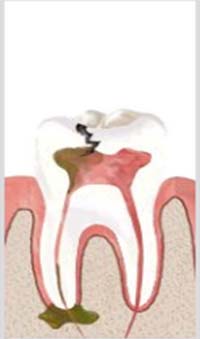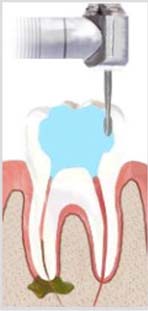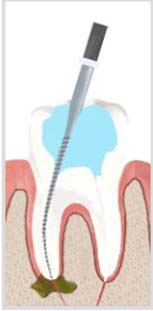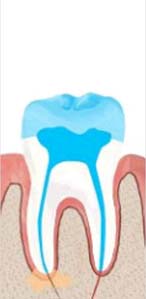Endodontics Kingsway
Root Canal Treatments
As Technology in dentistry advances, we approach our treatment techniques in different manners. In many special cases, we perform the entire root canal treatment in a single sitting and that too with an antibiotic coverage for about 2-3 days depending on the type of decay and oral health of the patient. In our single sitting RCT process, only mild pain relievers might be required
How is a Root Canal done?
Root canal treatment consists of several steps that take place over several office visits, depending on the situation. These steps are: An opening is made through the back of a front tooth or the crown of a molar or pre-molar.After the diseased pulp is removed (a pulpectomy), the pulp chamber and root canals are cleaned, enlarged and shaped in preparation for being filled.If more than one visit is needed, a temporary filling is placed in the crown opening to protect the tooth between dental visits.The temporary filling is removed and the pulp chamber and root canal permanently filled. A tapered, rubbery material called gutta-percha is inserted into each of the canals and is often sealed into place with cement. Sometimes a metal or plastic rod is placed in the canal for structural support.In the final step, a crown is usually placed over the tooth to restore its natural shape and appearance. If the tooth is very broken down, a post may be required to build it up prior to placing a crown.
How is a Root Canal done?
Depending on the circumstances our dentist might recommend Desensitizing toothpaste. After several applications desensitizing toothpaste can help block pain associated with sensitive teeth.Fluoride. Your dentist might apply fluoride to the sensitive areas of your teeth to strengthen tooth enamel and reduce pain.Covering exposed root surfaces. If receding gums are the cause of your sensitive teeth your dentist might apply a sealant to cover the exposed tooth roots.Root canal. If your sensitive teeth cause severe pain and other treatments are not effective your dentist might recommend a root canal a procedure used to treat problems in the tooth soft core (dental pulp).Bonding agent the material used to stick tooth colored restorations to teeth can be used to seal the dentin surface and provide a barrier to the stimuli that cause sensitivity To prevent sensitive teeth from recurring your dentist might offer suggestions to help you maintain your oral health. Twice a day brush your teeth with a soft-bristled toothbrush and fluoride toothpaste. Floss daily. Avoid vigorous or harsh scrubbing highly abrasive toothpaste and excessive brushing and flossing. If you grind your teeth ask your dentist about a mouth guard. Tooth grinding (bruxism) can fracture teeth and cause sensitivity.
When to See A Doctor About Tooth Sensitivity
While you can often self-treat generalized tooth sensitivity see your dentist ifYour teeth are persistently sensitive to pressure.A single tooth is persistently sensitive which could indicate that its pulp is infected or dying.Sensitivity does not decrease after two weeks of using desensitizing toothpaste.You have dental pain that lasts more than an hour.The gums around a sensitive tooth change color.You have any obvious decay.
We also do rotary endodontics with latest machinery like apex locators e.t.c.
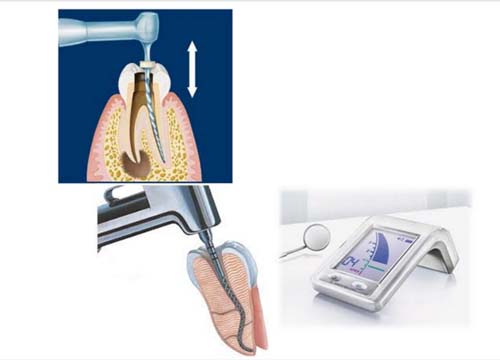
Single Sitting Root Canal Treatment
Full Mouth Rehabilitation is to correct the imperfections in bite position and enhance the appearance of the smile. The excellent candidate would be any one with short worn teeth or those that are chipped and broken throughout the mouth. Combining the science of Neuromuscular Dentistry with the artistry of Cosmetic Dentistry Full Mouth Rehabilitation creates a smile that is functional comfortable and beautiful. Full mouth rehabilitation includes Implants porcelain veneers crowns or onlays. As an added benefit the restorations are exceptionally attractive and strong enhancing the smile beautifully.
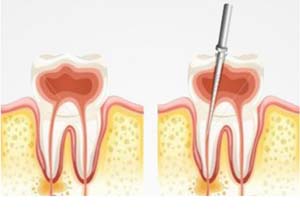
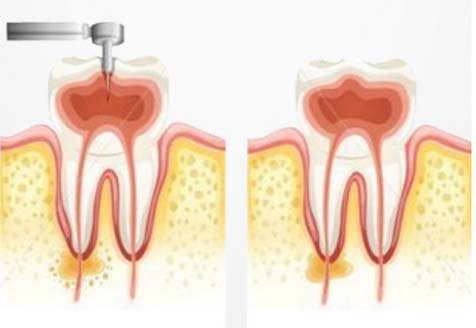
Mulitple Dental Tooth Implants are done when replacing several gaps if teeth. If there are missing gaps together, dental tooth implants with a bridge may be done. An implant bridge will consist of the crowns on dental tooth implants as well as pontic crowns. A pontic crown is a dental crown that is joined together to the anchor crowns on the dental tooth implants in forming a dental bridge.
Advantages of Single Visit Root canal
This treatment is done to avoid multiple injections & multiple visits, thus reducing the patient apprehension.Extremely comfortable.Generally completed in a single sitting of half an hour to one hour. Four to seven root canals can be performed in a single sitting.Pain is always associated with root canals, but should actually be little to no pain during single sitting procedure. All single sitting root canals are done in our clinic by experienced endodontists who exclusively practice root canals. The procedure is not for cosmetics, but rather your health. The infection will only get worse with time if left untreated. The biggest advantage is that the tooth will not need to be extracted in the future.
Apicoectomy
An apicoectomy is a procedure in which the endodontist opens the gum tissue near the tooth to see the underlying bone and to remove any inflamed or infected tissue. The very end of the root is also removed. n apicoectomy may be needed when an infection develops or persists after root canal treatment,or retreatment. During root canal treatment, the canals are cleaned, and inflamed or infected tissue is removed. Root canals are very complex, with many small branches off the main canal. Sometimes, even after root canal treatment, infected debris can remain in these branches and possibly prevent healing or cause re-infection later. In an apicoectomy, the root tip, or apex, is removed along with the infected tissue. A filling is then placed to seal the end of the root.
Apexification
Apexification is a treatment used to seal an open apex. The apex is the bottom part of a tooth’s root. Your teeth have tiny passageways called root canals. An open apex occurs when the root canals are not closed. Open root canals can lead to pulp exposure and infection. Pulp is the soft substance inside of your teeth. The pulp may be infected if an opening in the tooth allows bacteria inside. An open apex may be found in teeth that are not fully developed. An open apex may result if the root ends are eroded away by a process called resorption. Trauma may also cause an open apex. Ordinarily, pulp infections are treated with a root canal. An apexification is necessary if an open apex makes it too difficult to seal the root end with traditional root canal procedures. An apexification is a procedure that is used to form a hard barrier at the end of a root with an open apex.

